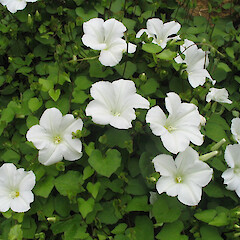Calystegia tuguriorum
Common name
climbing convolvulus, NZ bindweed
Synonyms
Convolvulus tuguriorum G.Forst.
Family
Convolvulaceae
Flora category
Vascular – Native
Endemic taxon
No
Endemic genus
No
Endemic family
No
Structural class
Lianes & Related Trailing Plants - Dicotyledons
NVS code
The National Vegetation Survey (NVS) Databank is a physical archive and electronic databank containing records of over 94,000 vegetation survey plots - including data from over 19,000 permanent plots. NVS maintains a standard set of species code abbreviations that correspond to standard scientific plant names from the Ngä Tipu o Aotearoa - New Zealand Plants database.
CALTUG
Chromosome number
2n = 22
Current conservation status
The conservation status of all known New Zealand vascular plant taxa at the rank of species and below were reassessed in 2017 using the New Zealand Threat Classification System (NZTCS) – more information about this can be found on the NZTCS website. This report includes a statistical summary and brief notes on changes since 2012 and replaces all previous NZTCS lists for vascular plants.
Please note, threat classifications are often suggested by authors when publications fall between NZTCS assessment periods – an interim threat classification status has not been assessed by the NZTCS panel.
- Conservation status of New Zealand indigenous vascular plants, 2017 . 2018. Peter J. de Lange, Jeremy R. Rolfe, John W. Barkla, Shannel P. Courtney, Paul D. Champion, Leon R. Perrie, Sarah M. Beadel, Kerry A. Ford, Ilse Breitwieser, Ines Schönberger, Rowan Hindmarsh-Walls, Peter B. Heenan and Kate Ladley. Department of Conservation. Source: NZTCS and licensed by DOC for reuse under the Creative Commons Attribution 4.0 International licence.
2017 | Not Threatened | Qualifiers: SO
Previous conservation statuses
2012 | Not Threatened
2009 | Not Threatened
2004 | Not Threatened
Distribution
Indigenous. North, South, Stewart and Chatham Islands. Present in Chile and on the Juan Fernandez islands
Habitat
Coastal to lowland. Usually in shrubland and along forest margins. occasional found on the margins of wetlands. It often favours grey scrub and bare lava or open rock strewn ground.
Wetland plant indicator status rating
Information derived from the revised national wetland plant list prepared to assist councils in delineating and monitoring wetlands (Clarkson et al., 2021 Manaaki Whenua – Landcare Research Contract Report LC3975 for Hawke’s Bay Regional Council). The national plant list categorises plants by the extent to which they are found in wetlands and not ‘drylands’. The indicator status ratings are OBL (obligate wetland), FACW (facultative wetland), FAC (facultative), FACU (facultative upland), and UPL (obligate upland). If you have suggestions for the Wetland Indicator Status Rating, please contact: [Enable JavaScript to view protected content]
FACU: Facultative Upland
Occasionally is a hydrophyte but usually occurs in uplands (non-wetlands).
Detailed description
Perennial vine or scrambling plant producing numerous, slender, much-branched puberulent twinning stems. Often forming dense patches. Petioles up to 40 mm, slender. Leaves (10-)40(-50) x (15-)30(-40) mm broad-ovate to deltoid or reniform, entire or sinuate; base cordate, sinus shallow and broad; apex acute to acuminate. Peduncules terete to slightly winged, (30-)110 mm long, > leaves. Bracts broadly ovate to suborbicular; base cordate, apex apiculate. Sepals similar to and < or = bracts. Corolla (25-)50 x (30-)60 mm diam., funnelform, white. Capsule 8-12 mm, broad-ovoid. Seeds orange, smooth.
Similar taxa
Could be confused with the only other consistently white-flowered Calystegia in New Zealand, C. marginata, which differs by its sagittate, fish-tailed leaves, shorter conspicuously winged peduncles, smaller flowers and black seeds which are ribbed and finely covered in protuberances. C. tuguriorum hybridises freely with C. soldanella.
Flowering
September - March
Flower colours
White
Fruiting
Present throughout the year.
Life cycle
Capsules are water and possibly also wind dispersed (Thorsen et al., 2009).
Propagation technique
Easy from seed and rooted pieces. Once established can be rather invasive and difficult to eradicate! Excellent growing through a hedge where the large white flowers can be seen to full effect and the creeping stems are more easily contained.
Etymology
calystegia: Name is derived from the Greek words kalyx ‘cup’, and stege ‘a covering’, meaning ‘a covered cup’, the calyx of some bindweeds being enclosed in two bracts.
tuguriorum: Growing around huts
Taxonomic Notes
Putative wild hybrids between this species and C. soldanella are common. Some collections suggest that it may also hybridise with C. sepium subsp. roseata.
Attribution
Fact sheet prepared for NZPCN by P.J. de Lange 1 November 2005. Description adapted from Allan (1961) and Webb et al. (1988), supplemented with observations made from fresh and dried material.
References and further reading
Allan, H.H. 1961: Flora of New Zealand. Vol. I. Wellington, Government Printer.
Thorsen, M. J.; Dickinson, K. J. M.; Seddon, P. J. 2009. Seed dispersal systems in the New Zealand flora. Perspectives in Plant Ecology, Evolution and Systematics 11: 285-309.
Wilcox, M.D. 2002. Calystegia tuguriorum in Auckland. Auckland Botanical Society Journal 57: 25
Webb, C.J.; Sykes, W.R.; Garnock-Jones, P.J. 1988: Flora of New Zealand. Vol. IV. Naturalised Pteridophytes, Gymnosperms, Dicotyledons.Christchurch, New Zealand, Botany Division, D.S.I.R..
NZPCN Fact Sheet citation
Please cite as: de Lange, P.J. (Year at time of access): Calystegia tuguriorum Fact Sheet (content continuously updated). New Zealand Plant Conservation Network. https://www.nzpcn.org.nz/flora/species/calystegia-tuguriorum/ (Date website was queried)












